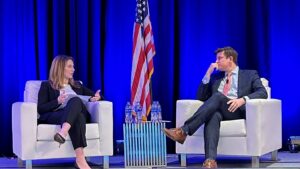With talent shortages challenging almost every sector of the economy, Governors and state workforce system leaders are focused on boosting the supply of both skills and of workers in the labor market.
Last month, the NGA Center for Best Practices (NGA Center) convened its two affiliate networks – the National Association of State Workforce Board Chairs and the National Association of State Liaisons for Workforce Development Partnerships – for its biannual Workforce Symposium in Washington, DC. Governors’ workforce policy advisors and Governor-appointed workforce development leaders from these two networks heard from subject matter experts and discussed two key, interconnected issues facing states: implementing the three major federal initiatives that passed the 117th Congress and confronting talent shortages in key sectors. Moreover, attendees explored the utility of sector-specific strategies, engaging workers who were formerly incarcerated, and welcoming legally present immigrants into the labor force.

The Symposium’s themes came together in a conversation on how states can collaborate with the Administration between the NGA Center’s Program Director for Workforce Development & Economic Policy, Rachael Stephens Parker, and the U.S. Department of Labor’s Acting Assistant Secretary of Employment and Training (ETA), Brent Parton. The conversation opened with an exchange on the Department’s vision for the role of the public workforce system, which is overseen by Governors, in carrying out the Biden-Harris Administration’s long-term workforce development priorities—including implementing IIJA, CHIPS and IRA, as well as improving job quality and filling shortages in other high-need fields like childcare, health care, and education. Parton’s placed the public workforce system, especially Governor-appointed state workforce development boards, in a central role aligning and coordinating workforce development strategies across these investments. While this vision constitutes the ideal role of the public workforce system and state boards as laid out in the Workforce Innovation and Opportunity Act, state boards frequently face hurdles from restrictive regulatory and statutory requirements and misaligned performance incentives.
Symposium participants subsequently engaged in a constructive exchange on how state and federal policymakers can partner to better support the goals laid out for the public workforce system—especially as they work to navigate their role in major federal investments that, while implicating them to action, do not legislate their roles in implementation. As a next step in supporting Governors and states in this work, NGA released a toolkit for states navigating the workforce development opportunities in the IIJA, CHIPS and IRA.
Following the conversation with Acting Assistant Secretary Parton, attendees engaged in sector-specific breakout discussions to cover strategies for addressing workforce shortages in childcare, construction, energy, and healthcare. Senior advisors from ETA facilitated these conversations and opened each session by detailing how ETA’s long-term vision will address talent shortages in these key sectors moving forward. Following ETA’s opening remarks, attendees engaged in solutions-oriented conversations and offered each other replicable best practices that can be deployed to meet demand. Participants shared recruitment and retention strategies, opportunities to offer stackable credentials, and ways to identify which federal funding streams can support these critical endeavors.
While these conversations elevated important strategies for addressing talent shortages by bringing more people into the labor force and building out sector-focused skills training strategies, state leaders recognize that talent shortages cannot be fully addressed without increasing labor supply. Governors of both parties have raised this issue at recent NGA convenings, including a virtual roundtable of Governors and CEOs co-hosted by NGA and the Business Roundtable in January and at one of the NGA Winter Meeting plenary sessions in February.
To build on this discussion and offer concrete steps that states can take to increase labor supply, the concluding session of the Symposium, moderated by the former Director of the Project on Workforce at Harvard University, Rachel Lipson, highlighted ways that states are engaging legally-present immigrants to fill talent shortages in high-need sectors. Mike Zimmer of World Education Services shared advice on debunking myths about the extent to which many immigrants’ and refugees’ skill sets align with the skill needs for open jobs, and how states are rethinking occupational licensing requirements to allow more entrants into critical occupations. Abdiwahab Mohamed, Assistant Commissioner of Immigrant and Refugee Affairs of the Minnesota Department of Employment and Economic Development, and Asha Parekh, Director of the Utah Refugee Services Office, discussed the geneses and goals of their offices – both of which were established with a focus on attracting and supporting immigrants and refugees. Mohamed, Parekh and Zimmer exchanged best practices in building connections across workforce development; English language learner and adult education programs; partnering with community organizations to provide wraparound supports; and how state and local workforce development boards can engage employers in setting immigrant and refugees up for success.
With talent shortages challenging almost every sector of the economy, Governors and state workforce system leaders are focused on boosting the supply of both skills and of workers in the labor market. In this endeavor, states have a unique opportunity to align workforce development strategies across programs and resources, particularly as they seek to leverage new and significant resources flowing to states via the IIJA, CHIPS and IRA. The success of these federal programs, their impact on communities across the country, and the health of the economy relies on the ability to fill jobs with adequately skilled talent. Governors and state workforce development policymakers are at the forefront of meeting the moment and building the workforce of the future.
This article was developed by NGA staff: Jack Porter and Rachael Stephens Parker. For more information on Governors’ workforce development efforts please contact communications@nga.org.












